Joseph (Josef – Note 1) Paul Sidel (Note 2) was born in Russia on 5 January 1874 (Note 3). He immigrated to the US on 20th June 1891 from Hamburg, Germany aged 16 (Note 4). He sailed on a ship belonging to the Hamburg-Amerikanische-Packetfahrt-Aktien-Gesellschaft (HAPAG) often referred to as the Hamburg America Line. He was considered short for a man, medium build with greyish brown eyes and brown hair.
At 22, he married his wife Sophie on 20 March 1896 in New York. Sophie was 19 at the time and had come to the US from Germany in 1893. She was a small woman at only 5.0 feet tall with a fair complexion. The couple had four children: Gertrude, Stella, Robert, and Coleman.
Joseph became a naturalised US citizen in 1900. At the time of the 1900 US census, Joseph was visiting his sister Tillie Abrams (nee Sidel). His occupation was listed as Salesman - Store. He was 25 years old.
On 13 May 1909, Sophie Sidel applied for a passport as she was returning to Germany with two of her children, Gertrude (aged 10) and Coleman (aged 4). She gives information on the form regarding her marriage to Joseph and her immigration to the United States. She also states that she was naturalised on 20 June 1903. The form is legally notarised. The name and address given as to where to send the passport to; “Joseph P Sidel, Lord and Bay View Avenue, Inwood, New York. This was then crossed out in her hand and replaced with the name and address of W.H.K. Davey, P.O. Box 419, Norfolk, N.Y. Mr Davey was a lawyer in Manhattan, New York. He is listed in the Phillips Business Directory of 1920 as having an office at 154 Nassau Street in Manhattan.
In 1910 the family were living at 68 Lord Avenue, Inwood, New York in a large, detached house. Joseph’s occupation currently was Merchant of Dry Goods. All the family were living at this address. They also employed a servant girl from Germany called Eda Hyman who was 18. She had arrived in New York from Germany in 1904.
On 12 September 1918, Joseph was drafted into the American War Effort for World War 1. America had declared war on Germany on December 17, 1917. As the war officially ended two months after on 11th November 1918 it is doubtful that Joseph even finished his basic training. He was 43. His occupation shown on his draft card was Silversmith (Employer) with premises at 40 John Street, Manhattan, New York. Interestingly, John Street, in Manhattan, leads into Nassau Street where W.H.K Davey – Joseph’s lawyer had his office.
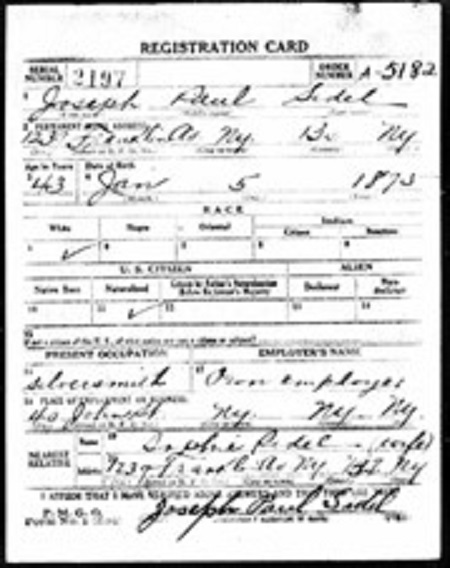
WW1 Draft Card showing Joseph P Sidal Signature.
The period from 1910 to 1918 shows great change for Joseph. In 1910 he considered himself a Merchant of Dry Goods, suggesting some sort of owner of a shop or an importer of dry goods. Regardless of this, by 1918 his profession had changed to manufacturer of silverware. This is important as he himself gave this information to the census official. He did not state Designer, Producer, or Maker but Manufacturer. It also records that he was an employer suggesting by 1918 he had some type of factory or production process for producing silverware for sale.
In 1920 they were renting an apartment at 1239 Franklin Avenue in the Bronx. What prompted this change from the large, detached house with a servant to a rented apartment we can only guess, perhaps he sold up and invested in his new business. Perhaps the war had given him a new perspective on life and what he wanted to accomplish. The census from that date shows that all the children were living with them at the apartment. Joseph’s occupation still showed he was a manufacturer of silverware. He is also listed as an employer.
By 1930 they had moved from the apartment and purchased a house valued at $12,000 at 254 Linwood Avenue, Cedarhurst, New York. Three of the children were living with them currently (aged 27, 25 and 23). None in the silver trade. Considering inflation, the house would be valued today at $198,000 (Note 6). This sum gives an indication as to Joseph’s income and success as a silverware manufacturer by 1930. It was at this time Joseph decided to list his birthplace as Poland.
There could be many reasons for this change of nationality. He had seen the emergence of dissent in Russia during the 1917 revolution (1917-1923) the redrawing of the map regarding Russian territories and what was spreading through US society at the time. Russian Americans were becoming victims of a wave of xenophobic panic. The Government feared the United States was in danger of its own communist revolution. Russian immigrants were singled out as a particular danger, and their unions, political parties, and social clubs were spied upon and raided by federal agents. In New York City more than 5,000 Russian immigrants were arrested. During the worst years of the Red Scare, 1919 and 1920, thousands of Russians were deported without a formal trial. As a result of this, the Russian American community began to keep a low profile. Fear of persecution led many Russians to convert to Protestantism, to change their names, and to deny their heritage to any outsiders.
Of course, changing your nationality on an official document has consequences. A sauce boat in the Margo Grant Walsh Collection in the Museum of Fine Arts in Houston, Texas lists Joseph P Sidel as being Polish-American. It is assumed this is where the provenance came from. However we can now be confident that this is incorrect as borne out by the documentation.
Joseph Sidel died in New York in February 1963. In the interim years from 1930 to his death it can be concluded that J.P. Sidel was in fact a purveyor of silver items and not a silversmith. As an employer he surely would have had designers and salespeople to produce and sell the works. The building where he registered his business at 40 John Street longer exists in Manhattan. It was demolished in 1968.
Shown below are some examples of J.P. Sidel pieces that have appeared in either auctions or collections. It is worth bearing in mind that Joseph would have had to learn his silver making skills after 1910 and prior to 1918 when we know he considered himself a manufacture of silverware rather than a designer/maker. It would be possible in that time perhaps to become proficient as a silversmith but without any previous training it is doubtful. Josephs skill set was about sales having listed being a salesman and merchant on the census up until at least 1918. Interestingly he could have marketed his silverwares with the designer or makers name and added "for J.P. Sidel". However this was not the case for reasons only known to Joseph.
The four photographs below show a Sterling Silver Triple Candelabra that was sold at auction in New York in December 2019. Typical of their type, they show excellent craftsmanship.
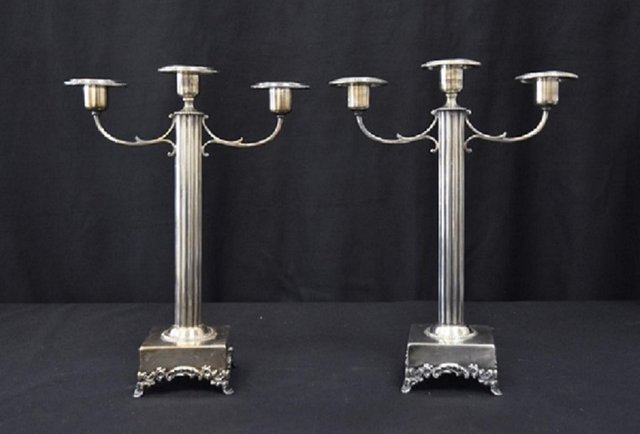

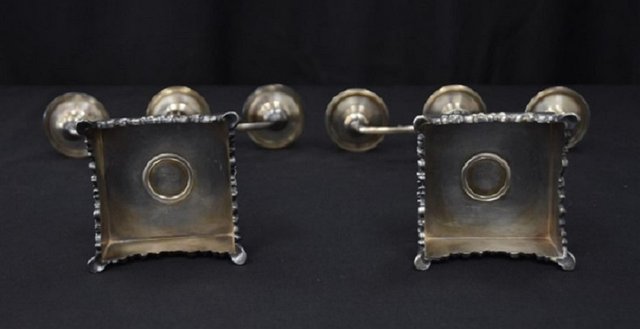
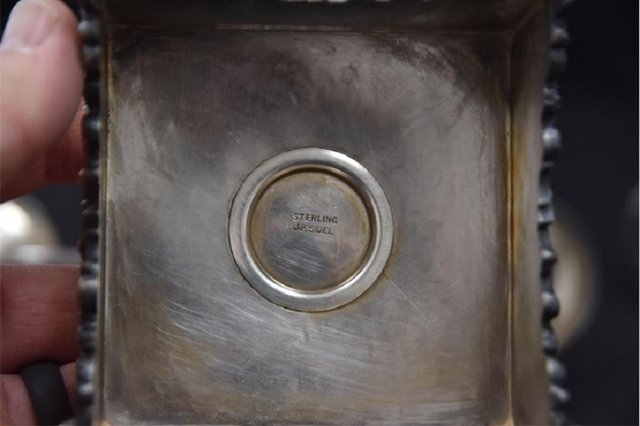
The piece shown below comes from the collection of Margo Grant Walsh. A celebrated American Architect and Interior Designer. It was part of the exhibition, The Graceful Table, Margo Grant Walsh, Twentieth Century Silver and Metalwork Collection at the Mackinnon Gallery, November 23rd, 2019, to November 8th, 2020. It is on display at the Houston Museum of Fine Arts.
This Sauce Boat also features in Collecting by Design: Silver and Metalwork of the Twentieth Century: the Margo Grant Walsh Collection (Houston Museum of Fine Arts) Yale University Press, Paperback – 1 April 2008

J.P. Sidel (Polish-American, (sic) (1875-1963) Sauce boat, ca 1930s. Sterling Silver. Margo Grant Walsh Twentieth Century Silver and Metalwork Collection (Note 7)
The image below is from Freemans Auction House in Philadelphia (Date unknown). It shows a hexagonally lobed bowel, very plain and typical of the art deco period This piece appeared in a sale of Early 20th Century Arts and Crafts Silver
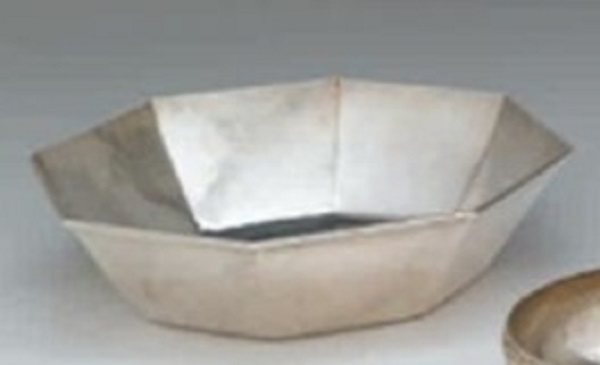
Hexagonally lobed bowel. Diam 6.5 inches
Further, in a sale at a Chicago Auction House on 1 and 2 May 2011 of American Arts and Crafts Silver, “A Creamer and Sugar Set by J.P. Sidel” was listed for sale. Unfortunately there was not a photograph to accompany this entry. It does tell us that Sidel was manufacturing high end table silverware in the Arts and Craft Style post 1910.
Drawing on all the evidence found we can conclude the above pieces were not designed and made by Joseph personally who appears not to have had any type of silversmith training prior to 1910 and yet by 1918 was producing items of beauty and to a very high standard.
Note 1:
Probably named at birth Josef but by 1910 it had changed to a more American way of saying Josef with a ph. Joseph. All records from 1910 onwards refer to Joseph.
Note 2:
One record added an additional (L) Sidell. It is often the case that the person writing the census made spelling errors regarding names particularly if they were not of US origin.
Note 3:
Place unknown at present.
Note 4:
Although only 16 at the time, no passenger list can be found at present for his departure. However, it is assumed he travelled at least with his sister Tillie, which is generally a variant/diminutive for the German name Matilda. In addition, it may be that SIDEL is an Americanised version of his surname like the Russian surnames SHIDEL, ZSIDEL, SAIDEL and SZIDEL and others.
Note 5:
Apartment number 7
Note 6:
In 2019 the house was sold for $675,000.
Note 7:
As it can now be established that J.D. Sidel was in fact Russian, would it be prudent to let the Huston Museum of Fine Art know that the sauce boat is miss attributed and providing documentary evidence?
The above content is my opinion based on research carried out in December 2021. As with any conclusions made, I could be wrong....... GH1